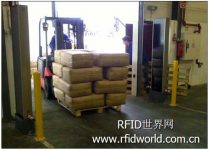
Glove manufacturers use RFID to obtain material visibility to improve inventory
[ad_1]
Marigold Industrial is a manufacturer of protective gloves that can protect hands from sharp knives, hazardous chemicals or frozen packages.In order to better obtain the visibility of glove manufacturing materials and improve the tracking ability of finished products, the company adopted a passive EPC Gen 2 RFID tag and reader RFID system in its Poiares factory in Portugal.
Earlier this year, this new system replaced the original paper tracking system and improved the accuracy of the factory’s internal inventory and shipping records. When the system is fully optimized, Marigold claims that it can also reduce the time required for inventory counting. CreativeSystems is responsible for integrating this system.
When the pallets of boxes of materials and parts (multiple grades of rubber and cloth) arrive at the factory, Marigold workers enter the corresponding order numbers on a computer connected to an RFID label printing and encoding machine. The Backoffice software running on the computer was developed by CreativeSystems and communicates with the SAP ERP system adopted by Marigold. The ERP software collects order details related to the order and then forwards the information to Backoffice software, which generates an RFID tag for each material box.
Each label is embedded with an Avery Dennison RFID inlay containing NXP Semiconductors UCode EPC Gen 2 chip. Backoffice assigns a unique ID code to the chip, which corresponds to the order information.
Each box is pasted with an RFID tag, and then passes through an RFID entrance and exit reader. At this time, Backoffice registers the data of the incoming goods and corresponds to the order information. If the box ID does not match the order number, the software sends an alert to notify the worker to check.

Labeled cargo boxes enter and exit an RFID entry and exit reader
After the labeled material boxes are put into the warehouse, they are counted once a month. Before the RFID system was adopted, employees manually counted warehouse inventory once a week, so the new system reduced labor time. However, Marigold RFID manager Miguel Roxo said that they have also encountered some problems in reading box tags and are currently working to improve the reading rate.
“In the beginning, we put labels on the boxes arbitrarily, then put the boxes on the pallets and transport them into the warehouse,” Roxo explained. “When we used Alien Technology EPC Gen 2 readers to read the tags, we found that some tags could not be read because the labeling position was on the inside of the pallet.”
Since the lint is discharged very densely in the cargo box, this problem is most prominent when reading the lint box. Because lint accounts for 60% of the warehouse inventory, and workers can only read 90% of tags with handheld devices, this is a big problem. By adjusting the position of the box on the pallet so that the label faces outwards and using a reader mounted on a forklift and connected to four independent antennas, Roxo believes that the company will greatly increase the reading rate to nearly 100%.
Marigold also uses RFID systems to track manufacturing and shipping processes. When the factory receives a glove order, the software prompts the worker to take out the material container needed to complete the order. When the box passes a reader entrance and exit between the warehouse and the production site, the RFID tag on the box is read, and the software tracks this action so that the management can see the number of boxes used for production and calculate it at any time The inventory quantity of the segment warehouse.
When the material is made into gloves, the finished product is placed in a labeling box (the same amount is placed in each box), and RFID is also used for tracking. Workers log in to the ERP software, collect existing order information, and match the data with the type and quantity of finished products. Next, Backoffice prints RFID shipping labels and sticks them on each finished product box. The ID of the label corresponds to the customer’s order.
The labeled boxes are taken directly to the shipping location and loaded onto pallets. The wholesaler takes some of the products, and the rest is shipped to a distribution center operated by Marigold.
Before the goods are loaded on the truck, each pallet is filmed to ensure the safety of the pallet. When the box rotates through the film, the RFID reader reads the RFID tags of all boxes.
At present, Roxo claims that RFID tags are only used inside the factory, and the company will eventually install readers in the distribution center to identify and track goods entering and leaving the center.
[ad_2]



